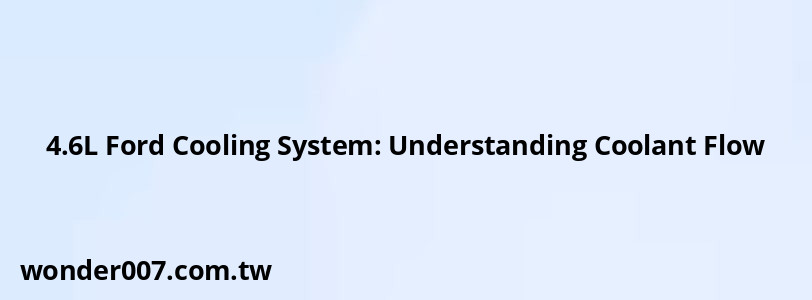4.6L Ford Cooling System: Understanding Coolant Flow

The cooling system in a Ford 4.6L engine is crucial for maintaining optimal operating temperatures and preventing overheating. This engine, commonly found in various Ford models, utilizes a specific coolant flow path to manage heat effectively. Understanding this flow is essential for both maintenance and troubleshooting.
Overview of Coolant Flow in the 4.6L Engine
The coolant flow in the 4.6L engine begins with the water pump, which is responsible for circulating coolant throughout the system. The following outlines the primary components and their roles:
- Water Pump: Located at the front of the engine, it pumps coolant into the water jacket.
- Water Jacket: Coolant travels down around the cylinders, absorbing heat.
- Cylinder Heads: After circulating around the cylinders, coolant moves up into the cylinder heads.
- Intake Crossover: The heated coolant exits the heads and enters the intake crossover before reaching the thermostat.
- Thermostat: This component regulates coolant flow to the radiator based on temperature.
- Radiator: The coolant releases heat here before returning to the water pump.
Additionally, the heater core is fed from the back of the engine, allowing for cabin heating by routing hot coolant back to the intake crossover area.
Detailed Coolant Flow Path
| Component | Function |
|---|---|
| Water Pump | Pumps coolant into the water jacket |
| Water Jacket | Circulates coolant around cylinders |
| Cylinder Heads | Receives coolant from water jacket |
| Intake Crossover | Transfers heated coolant to thermostat |
| Thermostat | Controls flow to radiator based on temperature |
| Radiator | Cools down heated coolant before recirculation |
| Heater Core | Provides heat for cabin by using hot coolant |
Understanding this flow path is essential for diagnosing issues such as overheating or leaks in the system.
Importance of Proper Coolant Maintenance
Maintaining proper coolant levels and quality is vital for engine health. Important info includes:
- Regularly check and replace coolant as needed to prevent corrosion and scale buildup.
- Inspect hoses and connections for leaks or wear that could disrupt flow.
- Ensure that the thermostat is functioning correctly to maintain optimal operating temperatures.
By keeping these components in good condition, you can enhance your engine's performance and longevity.
FAQs About 4.6L Ford Cooling System
- What are common signs of a cooling system issue?
Common signs include overheating, coolant leaks, and fluctuating temperature readings. - How often should I change my coolant?
It’s recommended to change your coolant every 30,000 miles or as specified in your owner’s manual. - Can I use any type of coolant?
No, always use a coolant that meets Ford specifications for optimal performance.
Related Posts
-
2014 Ford Focus Speedometer Troubleshooting Guide
30-01-2025 • 120 views -
Coolant Reservoir to Radiator: Essential Guide for Vehicle Owners
28-01-2025 • 193 views -
Toyota Camry Check Charging System: Causes and Fixes
28-01-2025 • 163 views -
2018 Ford Explorer: Transmission Fluid Capacity Guide
29-01-2025 • 232 views -
Phone Button With Blinking Blue Light: Understanding Its Meaning
27-01-2025 • 149 views
Latest Posts
-
Power Steering Fluid Leak On Passenger Side
01-02-2025 • 461 views -
2015 Chevy Traverse AC Recharge Port Location
01-02-2025 • 418 views -
Are O2 Sensors Covered Under Warranty
01-02-2025 • 378 views -
How To Turn Off Paddle Shifters Mercedes
01-02-2025 • 387 views -
Rear Brake Caliper Piston Won't Compress
01-02-2025 • 361 views
Popular Posts
-
EPC Light: Understanding Causes and Solutions
26-01-2025 • 1065 views -
Toyota Hiace: Fuel Efficiency Insights for 2025
26-01-2025 • 646 views -
Power Steering and ABS Light On: Causes and Solutions
27-01-2025 • 650 views -
V12 Engine Costs: What You Need to Know
26-01-2025 • 688 views -
Hino Warning Lights: Understanding Dashboard Alerts
26-01-2025 • 795 views
